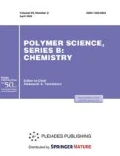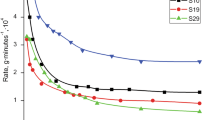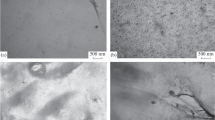Abstract
The polymer–polymer composites bearing polyethylene and starch are obtained by polymerization filling. The polymerization of ethylene is carried out using catalyst system [TiCl4 + (С2H5)2AlCl] under mild conditions. It is found that the catalyst activity in the presence of a biopolymer is higher than that without the filler. The polyethylene matrix has a molecular mass of 1.26–1.40 M and features a melting point of 138–140°C, a high enthalpy, and a degree of crystallinity of 60–70%. Reduction in the decomposition temperature of the polymer–polymer composites and in the rate of mass loss compared to the unfilled polyethylene and biopolymers is detected. The stress-strain characteristics of the polymer matrix are improved; in particular, the elastic modulus and relative elongation at break are increased. The photooxidative degradation of the composites under the action of sunlight and UV radiation is studied. According to the data of IR spectroscopy, the polymer–polymer composites possess resistance to photooxidative aging 2–3 times lower than the unfilled polyethylene. The polymer–polymer composites subjected to UV radiation reveal a high intensity of growth of microorganisms: the degree of biofouling is up to four points.
Similar content being viewed by others
References
A. C. Albertson and S. Karlsson, in Chemistry and Technology of Biodegradable Polymers, Ed. by G. J. L. Griffin (Blackie, Glasgow, 1994).
V. A. Vasnev, Polym. Sci., Ser. B 39 (11–12), 474 (1997).
S. Z. Rogovina, A. V. Grachev, K. V. Aleksanyan, and E. V. Prut, Russ. J. Bioorg. Chem. 37 (7), 791 (2011).
S. Z. Rogovina, S. M. Lomakin, K. V. Aleksanyan, and E. V. Prut, Russ. J. Phys. Chem. B 6 (3), 416 (2012).
A. I. Suvorova, I. S. Tyukova, and E. I. Trufanova, Russ. Chem. Rev. 69 (5), 451 (2000).
M. Kaseem, K. Hamad, and F. Deri, Polym. Sci., Ser. A 54 (2), 165 (2012).
F. S. D’yachkovskii and L. A. Novokshonova, Russ. Chem. Rev. 53, 117 (1984).
L. A. Novokshonova, P. N. Brevnov, V. G. Grinev, S.N. Chvalun, S. M. Lomakin, and A. N. Shchegolikhin, Nanotechnol. Russ. 3 (5–6), 330 (2008).
A. D. Pomogailo, Polymer Immobilized Metallocomplex Catalysts (Nauka, Moscow, 1988) [in Russian].
E. M. Khar’kova, D. I. Mendeleev, Y. M. Korolev, B. F. Shklyaruk, V. A. Gerasin, and E. M. Antipov, Polym. Sci., Ser. A 55 (8), 493 (2013).
E. M. Khar’kova, D. I. Mendeleev, V. A. Aulov, B. F. Shklyaruk, V. A. Gerasin, A. A. Piryazev, and A. E. Antipov, Polym. Sci., Ser. A 56 (1), 72 (2014).
A. Tidjani, R. Arnaud, and A. Dasilva, J. Appl. Polym. Sci. 47 (2), 211 (1993).
D. Hadad, S. Geresh, and A. Sivan, J. Appl. Microbiol. 98 (5), 109 (2005).
A. Corti, S. Muniyasamy, M. Vitali, S. H. Imam, and E. Chiellini, Polym. Degrad. Stab. 95 (6), 1106 (2010).
F. S. D’yachkovskii, A. D. Pomogailo, and A. N. Ponomarev, in Complex Organometallic Catalysts of Olefin Polymerization. Collection (Chernogolovka, Bukinist, 1978), No. 7, p. 46 [in Russian].
A. D. Pomogailo, in Complex Organometallic Catalysts of Olefin Polymerization. Collection (Chernogolovka, Bukinist, 1991), No. 11, p. 116 [in Russian].
A. D. Pomogailo, Russ. Chem. Rev 71 (1), 1 (2002).
S. Z. Rogovina, K. V. Aleksanyan, D. D. Novikov, E. V. Prut, and A. V. Rebrov, Polym. Sci., Ser. A 51 (5), 554 (2009).
A. Ammala, S. Bateman, K. Dean, and E. Petinakis, Prog. Polym. Sci. 36 (8), 1015 (2011).
Author information
Authors and Affiliations
Corresponding author
Additional information
Original Russian Text © E.M. Khar’kova, D.I. Mendeleev, M.A. Guseva, B.F. Shklyaruk, V.A. Gerasin, E.M. Antipov, 2017, published in Vysokomolekulyarnye Soedineniya, Seriya B, 2017, Vol. 59, No. 5, pp. 393–401.
Rights and permissions
About this article
Cite this article
Khar’kova, E.M., Mendeleev, D.I., Guseva, M.A. et al. Starch–polyethylene polymer–polymer composites obtained by polymerization filling: Structure and oxidative degradability. Polym. Sci. Ser. B 59, 601–609 (2017). https://doi.org/10.1134/S1560090417050050
Received:
Revised:
Published:
Issue Date:
DOI: https://doi.org/10.1134/S1560090417050050




